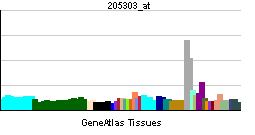KCNJ8
| Potassium inwardly-rectifying channel, subfamily J, member 8 | |||||||||||
|---|---|---|---|---|---|---|---|---|---|---|---|
| Identifiers | |||||||||||
| Symbols | KCNJ8 ; KIR6.1; uKATP-1 | ||||||||||
| External IDs | Template:OMIM5 Template:MGI HomoloGene: 3654 | ||||||||||
| |||||||||||
| RNA expression pattern | |||||||||||
 | |||||||||||
 | |||||||||||
| More reference expression data | |||||||||||
| Orthologs | |||||||||||
| Template:GNF Ortholog box | |||||||||||
| Species | Human | Mouse | |||||||||
| Entrez | n/a | n/a | |||||||||
| Ensembl | n/a | n/a | |||||||||
| UniProt | n/a | n/a | |||||||||
| RefSeq (mRNA) | n/a | n/a | |||||||||
| RefSeq (protein) | n/a | n/a | |||||||||
| Location (UCSC) | n/a | n/a | |||||||||
| PubMed search | n/a | n/a | |||||||||
Potassium inwardly-rectifying channel, subfamily J, member 8, also known as KCNJ8 or KIR6.1, is a human gene.[1]
Potassium channels are present in most mammalian cells, where they participate in a wide range of physiologic responses. The protein encoded by this gene is an integral membrane protein and inward-rectifier type potassium channel. The encoded protein, which has a greater tendency to allow potassium to flow into a cell rather than out of a cell, is controlled by G-proteins.[1]
See also
References
Further reading
- Kubo Y, Adelman JP, Clapham DE; et al. (2006). "International Union of Pharmacology. LIV. Nomenclature and molecular relationships of inwardly rectifying potassium channels". Pharmacol. Rev. 57 (4): 509–26. doi:10.1124/pr.57.4.11. PMID 16382105.
- Inagaki N, Tsuura Y, Namba N; et al. (1995). "Cloning and functional characterization of a novel ATP-sensitive potassium channel ubiquitously expressed in rat tissues, including pancreatic islets, pituitary, skeletal muscle, and heart". J. Biol. Chem. 270 (11): 5691–4. PMID 7890693.
- Inagaki N, Inazawa J, Seino S (1996). "cDNA sequence, gene structure, and chromosomal localization of the human ATP-sensitive potassium channel, uKATP-1, gene (KCNJ8)". Genomics. 30 (1): 102–4. doi:10.1006/geno.1995.0018. PMID 8595887.
- Suzuki M, Kotake K, Fujikura K; et al. (1998). "Kir6.1: a possible subunit of ATP-sensitive K+ channels in mitochondria". Biochem. Biophys. Res. Commun. 241 (3): 693–7. doi:10.1006/bbrc.1997.7891. PMID 9434770.
- Erginel-Unaltuna N, Yang WP, Blanar MA (1998). "Genomic organization and expression of KCNJ8/Kir6.1, a gene encoding a subunit of an ATP-sensitive potassium channel". Gene. 211 (1): 71–8. PMID 9573340.
- Surah-Narwal S, Xu SZ, McHugh D; et al. (1999). "Block of human aorta Kir6.1 by the vascular KATP channel inhibitor U37883A". Br. J. Pharmacol. 128 (3): 667–72. doi:10.1038/sj.bjp.0702862. PMID 10516647.
- Tucker SJ, Ashcroft FM (1999). "Mapping of the physical interaction between the intracellular domains of an inwardly rectifying potassium channel, Kir6.2". J. Biol. Chem. 274 (47): 33393–7. PMID 10559219.
- Kono Y, Horie M, Takano M; et al. (2001). "The properties of the Kir6.1-6.2 tandem channel co-expressed with SUR2A". Pflugers Arch. 440 (5): 692–8. PMID 11007308.
- Cui Y, Giblin JP, Clapp LH, Tinker A (2001). "A mechanism for ATP-sensitive potassium channel diversity: Functional coassembly of two pore-forming subunits". Proc. Natl. Acad. Sci. U.S.A. 98 (2): 729–34. doi:10.1073/pnas.011370498. PMID 11136227.
- Liu Y, Ren G, O'Rourke B; et al. (2001). "Pharmacological comparison of native mitochondrial K(ATP) channels with molecularly defined surface K(ATP) channels". Mol. Pharmacol. 59 (2): 225–30. PMID 11160857.
- Giblin JP, Cui Y, Clapp LH, Tinker A (2002). "Assembly limits the pharmacological complexity of ATP-sensitive potassium channels". J. Biol. Chem. 277 (16): 13717–23. doi:10.1074/jbc.M112209200. PMID 11825905.
- Vanoye CG, MacGregor GG, Dong K; et al. (2002). "The carboxyl termini of K(ATP) channels bind nucleotides". J. Biol. Chem. 277 (26): 23260–70. doi:10.1074/jbc.M112004200. PMID 11956191.
- Miki T, Suzuki M, Shibasaki T; et al. (2002). "Mouse model of Prinzmetal angina by disruption of the inward rectifier Kir6.1". Nat. Med. 8 (5): 466–72. doi:10.1038/nm0502-466. PMID 11984590.
- Nakamura K, Hirano J, Itazawa S, Kubokawa M (2002). "Protein kinase G activates inwardly rectifying K(+) channel in cultured human proximal tubule cells". Am. J. Physiol. Renal Physiol. 283 (4): F784–91. doi:10.1152/ajprenal.00023.2002. PMID 12217870.
- Curley M, Cairns MT, Friel AM; et al. (2003). "Expression of mRNA transcripts for ATP-sensitive potassium channels in human myometrium". Mol. Hum. Reprod. 8 (10): 941–5. PMID 12356945.
- Strausberg RL, Feingold EA, Grouse LH; et al. (2003). "Generation and initial analysis of more than 15,000 full-length human and mouse cDNA sequences". Proc. Natl. Acad. Sci. U.S.A. 99 (26): 16899–903. doi:10.1073/pnas.242603899. PMID 12477932.
- Singh H, Hudman D, Lawrence CL; et al. (2004). "Distribution of Kir6.0 and SUR2 ATP-sensitive potassium channel subunits in isolated ventricular myocytes". J. Mol. Cell. Cardiol. 35 (5): 445–59. PMID 12738227.
- Insuk SO, Chae MR, Choi JW; et al. (2003). "Molecular basis and characteristics of KATP channel in human corporal smooth muscle cells". Int. J. Impot. Res. 15 (4): 258–66. doi:10.1038/sj.ijir.3901013. PMID 12934053.
- Emanuele E, Falcone C, Carabela M; et al. (2004). "Absence of Kir6.1/KCNJ8 mutations in Italian patients with abnormal coronary vasomotion". Int. J. Mol. Med. 12 (4): 509–12. PMID 12964027.
- Gerhard DS, Wagner L, Feingold EA; et al. (2004). "The status, quality, and expansion of the NIH full-length cDNA project: the Mammalian Gene Collection (MGC)". Genome Res. 14 (10B): 2121–7. doi:10.1101/gr.2596504. PMID 15489334.
External links
- KCNJ8+protein,+human at the US National Library of Medicine Medical Subject Headings (MeSH)
| Stub icon | This membrane protein–related article is a stub. You can help Wikipedia by expanding it. |
This article incorporates text from the United States National Library of Medicine, which is in the public domain.